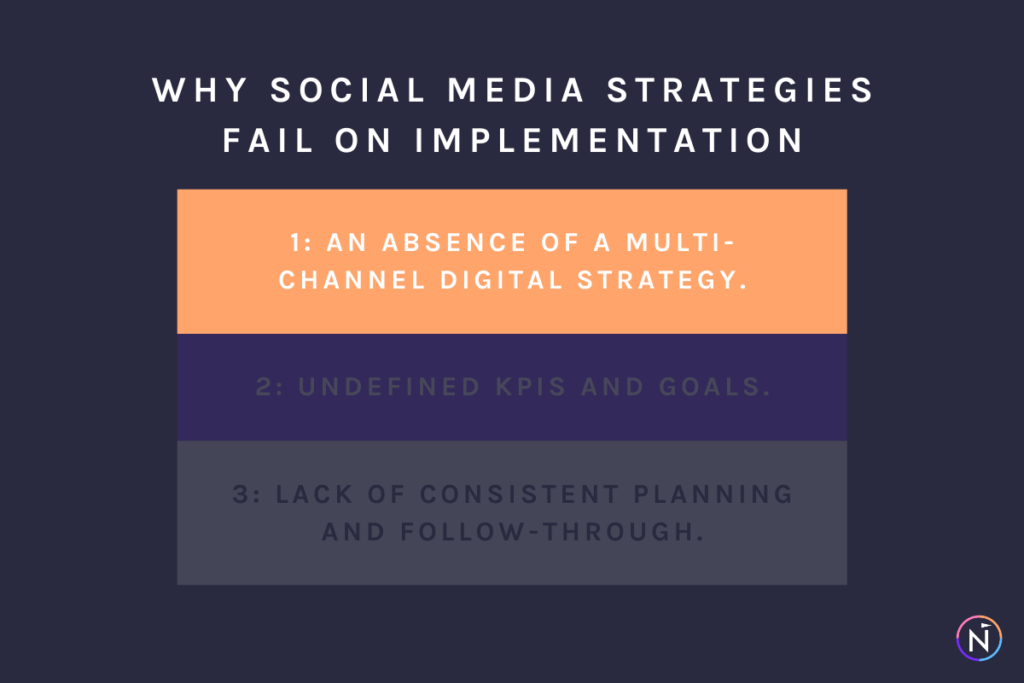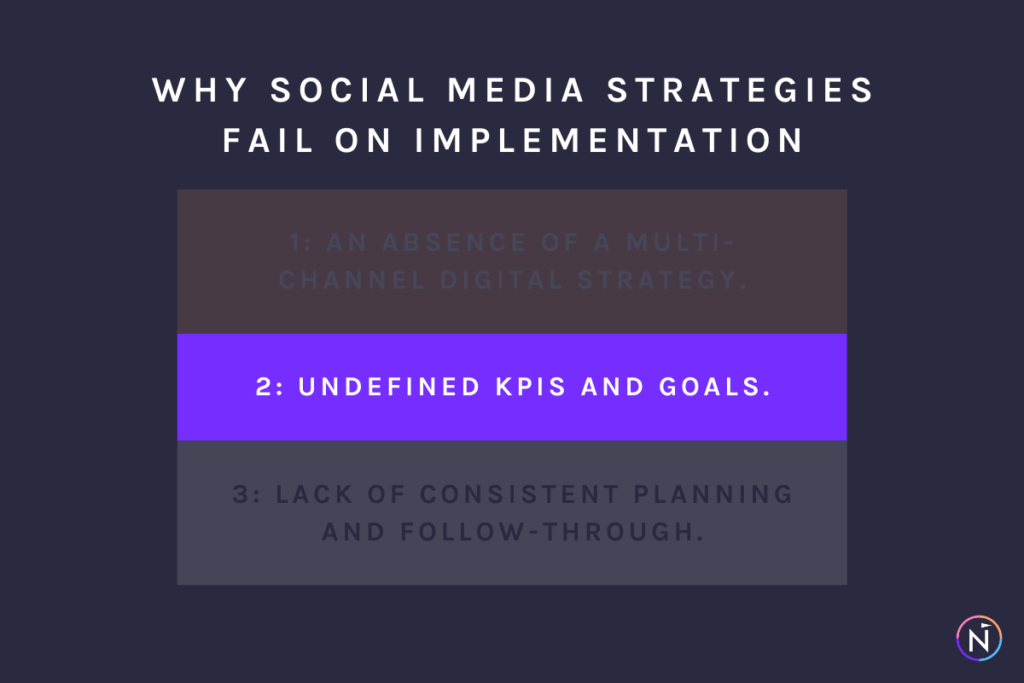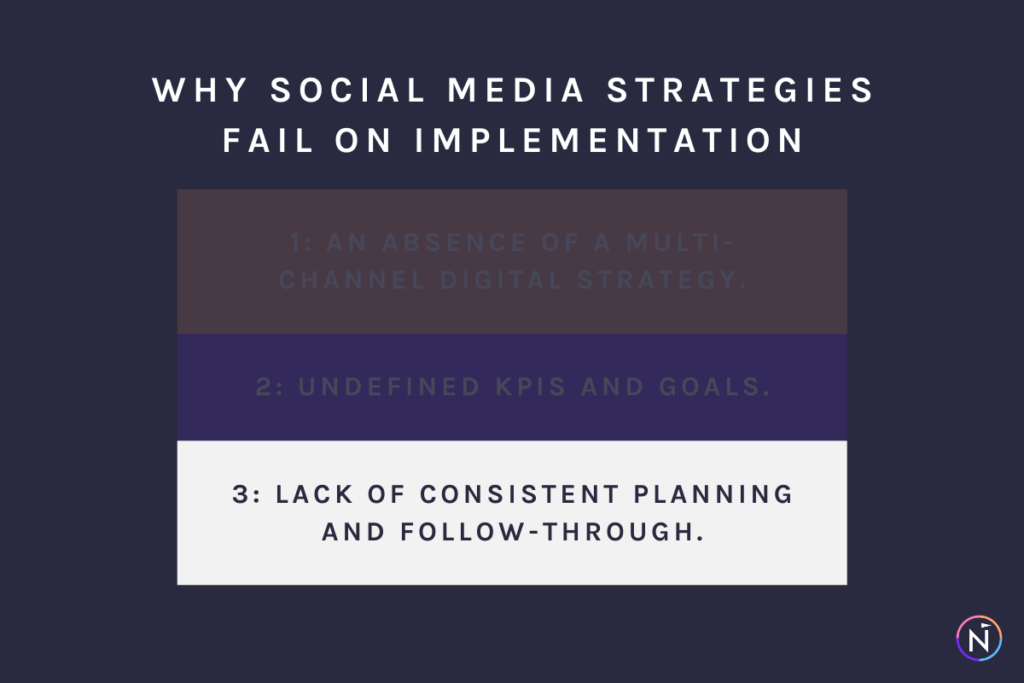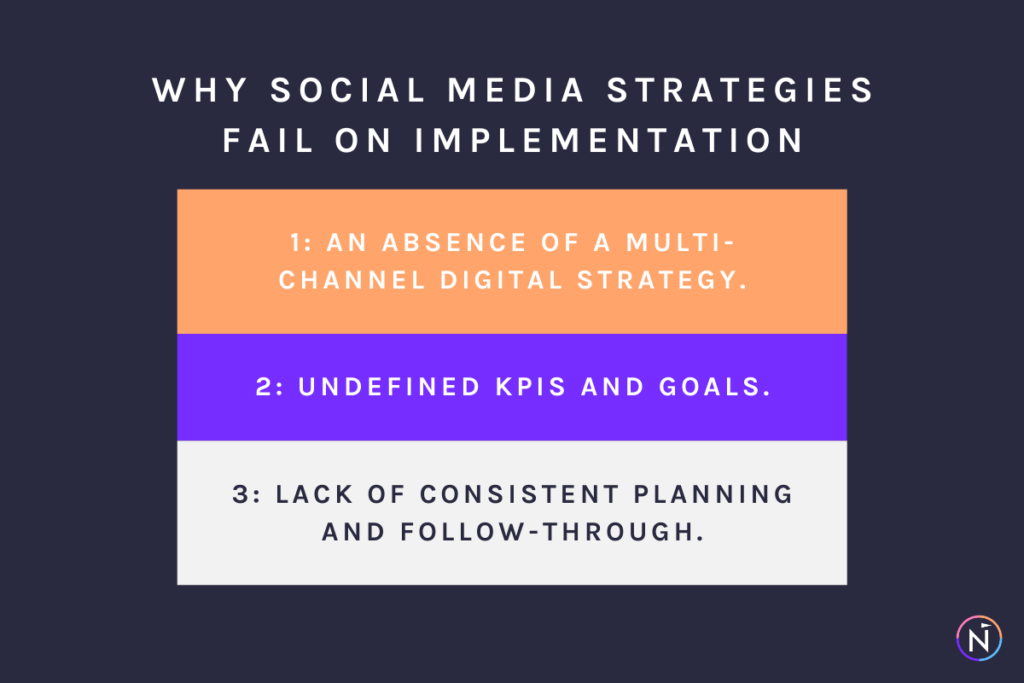It’s something we, as marketers, see time and time again. Your organization starts a new social media program: everyone is jazzed about it for a few weeks, maybe a few months, and then eventually… it fizzles. Why social media strategies fail on implementation remains a mystery to many organizations!
Why do so many social media strategies fail on implementation?
Hint: it’s most likely not because the team is lazy!
In my eyes, there are three main reasons why social media strategies fail on implementation.
- Absence of a multi-channel digital strategy.
- Undefined KPIs and goals.
- Lack of consistent planning and follow-through.
Let’s start at the top of every strategy (or at least, what should be at the top of every strategy).
1. An absence of a multi-channel digital strategy.

Let’s start at the top: with the multi-channel digital marketing strategy. In an ideal world, every organization would have a defined strategy and be able to plan the resources needed to achieve business sales targets. It’s an all-in plan that accounts for every channel (hence, multi-channel); everything from social to direct mail to your website to tradeshows would all be thought about.
In order to have a truly successful multi-channel marketing plan, the plan must outline the communication techniques and channels required for customer acquisition for every service or product your business offers. Allowing this to come together under one cohesive and comprehensive plan means that you can connect all your channels into one kick-ass approach and overall strategy.
What this really goes back to is direction: without direction, how can anyone be expected to steer a ship the right way? Having a solid strategy is essential for making any digital marketing effort work. Without it, every team is likely to aimlessly wander around for a while.
If you’re just starting out with the ideas of multi-channel marketing or just having an overall strategy, here are some questions that can act as a great jumping-off point:
- Where are we starting from? What do we already have established that works?
- Where do we want to be? What business and revenue goals are we trying to reach?
- What are the best strategies, channels, and tactics to help us get there?
- Where are our ideal customers and how do we reach them?
- What defines success?
Want to increase the number of people who demand your products, improve your processes and eliminate bottlenecks using marketing automation? Check our Whitepaper: People, Process & Bottlenecks:
Achieving Business Value with Marketing Automation
2. Undefined KPIs and goals.

Speaking of defining success, let’s talk about Key Performance Indicators (KPIs) and goals. This isn’t anything groundbreaking either, but there’s something to be said for reiteration: if you don’t define success, you’ll never be able to reach it.
Metrics and data analysis can be intimidating for a lot of marketers who fall on the more “creative” side (myself included at one point!), but it really doesn’t have to be. KPIs and goals are important because they help to define how to determine whether something is being successful.
And I truly believe this is why a lot of social media implementation strategies fail: there isn’t enough focus on defining success and failure. It shouldn’t be left up to chance!
Some more questions to ask yourself:
- What are your business’s most important KPIs? (Sales, demos, sign-ups, etc.)
- Which KPI is the main goal or focus of your social strategy?
- What defines whether a channel is a success?
- What defines whether a channel is a failure?
PS — I used to consult small businesses on social media strategy and I learned pretty quickly that there was unlikely to be an easy road ahead if the client wasn’t serious about measurements and defining their goals. Always define what success and failure mean for your business, for your marketing department, and for each channel/tactic that you’re adding into your customer journey.
Implementing UTM to help track your KPIs and goals? Check out our easy-to-use, easy-to-share Google Sheets UTM Generator Spreadsheet template takes the monotony and human error out of the UTM equation.
3. Lack of consistent planning and follow-through.

Lack of follow-through is what most people probably attribute social media failures to, but that’s only one half of the situation! The other half is consistent and intentional planning of paid and organic social posts.
Content is a machine.
It requires planning, upkeep, and maintenance. There is absolutely some automation that can be super helpful, but without planning, the team will be stuck publishing the same tired, dry blog posts and resources. It creates a content funnel that doesn’t provide anything new for the reader.
Instead of focusing solely on product and follow-through with posting and advertising campaign management, intent should be pushed towards the entire creative process. Starting at the very beginning of the customer journey
The landscape of every industry is constantly changing — can you imagine explaining how 2020 has gone to somebody a year ago? All the changes this year have affected most of our businesses and organizations in some way or another. Every industry and every business is always changing; these pivots, small or large, are all important parts of the planning process. Making your social strategy reflect everything that’s going on will be invaluable to the success of your campaigns.
What does that look like for each organization?
Here are some ideas to help you get started.
- What kind of content does the organization want to be published on a regular basis?
- What’s going on in your industry? What changes are occurring?
- What type of coordination needs to happen to be able to publish content at the cadence that you want? (Do you depend on other teams to write certain types of content like (Software as a Service) SaaS support documentation or Public Relations (PR) messages from the CEO?)
- What content performs best for SEO purposes?
- What company-wide, industry-wide, or world-wide events are coming up for your organization that would affect your content calendar and strategy?
- Where are the gaps in content? Does the organization have pieces of content relevant to every step in your customer journey and sales funnel?
- What does your ideal customer want to be reading?
- Which types of content have had the best success (back to those KPIs!) with both organic and paid social campaigns?
Want more 5 simple steps to great social media content? Check out our blog post.
Those are the three biggest reasons why social media strategies fail on implementation!
By planning a multi-channel digital strategy, defining success and failure for your social campaigns, and consistently planning your content, those social media strategies will be successes in implementation instead of failures!

To your success!
Sarah Augustinsky
Marketing at Net-Results
P.S. — Don’t forget to subscribe to the blog below so you don’t miss out on what’s new in marketing and what’s going on with marketing automation, plus digital marketing tips and tricks right to your inbox!

